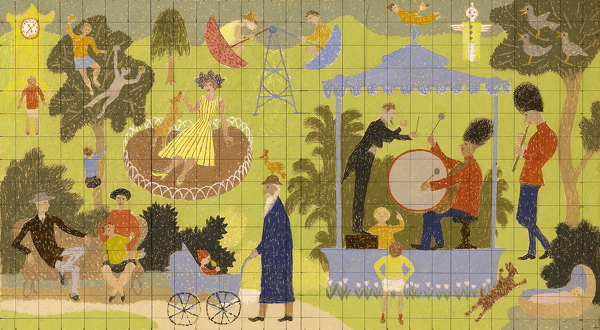

 Hover over the painting to magnify (there may be an initial delay while the magnified image is loaded)
Hover over the painting to magnify (there may be an initial delay while the magnified image is loaded)John Armstrong (1893-1973):
Studies for Royal Marsden Hospital in Sutton, Surrey, 1961
Unframed (ref: 5358)
Gouache on paper, six panels,
two 21 x 17.8 cm (8 1/4 x 7 in.)
two11.7 x 31.3 cm (4 5/8 x 12 3/8 in.)
two 21 x 34.5 cm (8 1/4 x 13 1/2 in.)
See all works by John Armstrong gouache panel leisure murals
Provenance: The Artist’s Estate
Literature: Andrew Lambirth, John Armstrong, Philip Wilson Publishers, 2009, p.224;
British Murals and Decorative Painting 1920-1960, Sansom & Co, 2013, pp.276-289
In 1961, Armstrong received his last mural commission to decorate a reception area in the Royal Marsden Hospital in Sutton, Surrey. The whole scheme took him two years to paint on canvas panels, squared up from small oil-on-card designs. The mural was subsequently destroyed, but the designs remain to demonstrate the humour and vitality, the inventiveness and visual wit, that Armstrong brought to their conception.
Entitled The Fantastic Park, the subject resembles one of the mythical settings from P.L.Travers’ Mary Poppins books, where normal rules don’t apply, and anything can happen (and probably will). The bright colours (sap green, scarlet, mauve) add to the air of celebration and unreality, and Armstrong subverts the usual park activities, with
children riding on the lake on real swans, regaled by a trombonist in a busby, up to his thighs in water.
Armstrong wrote a detailed commentary on the composition: ‘Bandsmen and children everywhere, that is the keynote of the Park. The bandstand is too small, it will hold only the conductor and the big drum. The rest of the band sit here and there wherever they feel disposed, with a kind of stereophonic effect.’ Besides the P.L.Travers reference, there’s a Dylan Thomas-ish Under Milk Wood feeling to the events. A little girl brings goldfish for her grandfather to catch. ‘He has been fishing all morning,’ wrote Armstrong, ‘and has had no luck. Her aunts are also bringing the stuffed fish off the chimney-piece.’ Frivolity meets anarchy in mutual admiration: there’s a Stanley Spencer-ish note to the festivities, a breath of unexpected love among the participants. Armstrong’s text concludes: ‘On the right a bandsman gives up and wipes his forehead. He has got a pint from somewhere.... The lake mermaid has come out to have a better view and has found a boy-friend. On a seat the poet and his muse meditate.’ (Andrew Lambirth, British Murals & Decorative Painting 1920-1960, Sansom & Co, 2013, pp.286-87)
 British Murals
British Murals SOLD
SOLD




